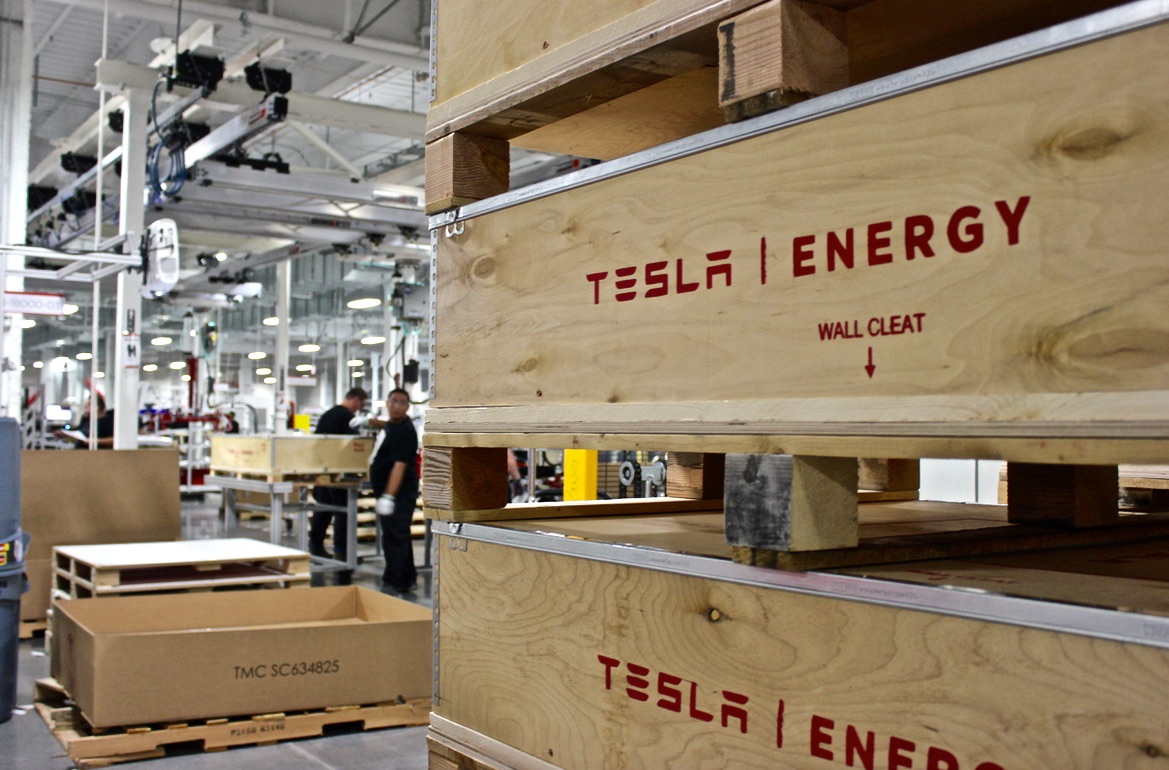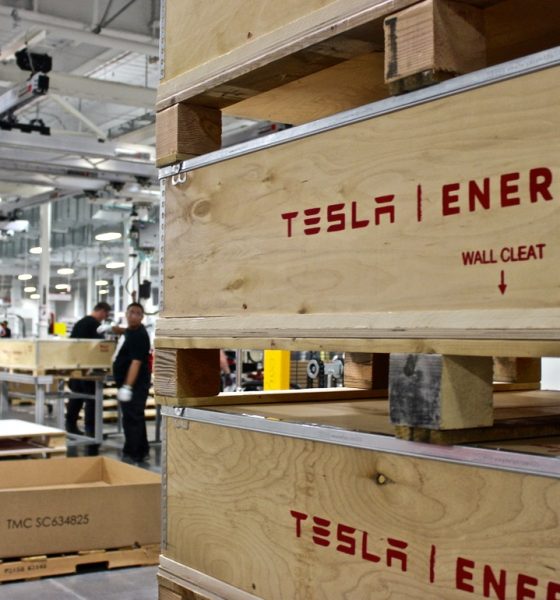

News
Tesla is giving high school grads Gigafactory jobs as apprenticeship program enters 3rd year
At Tesla’s Gigafactory 1 in Sparks, Nevada, local high school graduates have had the opportunity since 2017 to participate in two-year apprenticeships hosted by the electric vehicle manufacturer. As the program heads into its third year, the company is searching for 50-60 juniors and seniors to take part in the full-time hours, full-time benefits opportunity combining hands-on manufacturing job training with personal development support. Tesla has a history of investing in its local communities, making this program yet another nod to their commitment to embracing those supporting their mission of driving towards a sustainable energy future.
High school graduates in the program will primarily learn to build electric batteries and motors for Tesla’s product lines, but also included in the Reno Gigafactory apprenticeship is a 20-credit educational program through Truckee Meadows Community College, a local school. Additionally, personal and financial development classes and workshops are offered as well as reserved housing, all at the pay rate of $17 per hour with full employee benefits. The hours at the factory accommodate the educational schedule – each week alternating three 12-hour shifts and four 10-hour shifts.
There’s no guarantee of a permanent Tesla job at the end of the program, but according to Chris Reilly, head of workforce development and education programs at Tesla, several students from the completed programs have already been hired. Also, the skills acquired provide students with the ability to continue growing in similar industries or vocations. In 2018, 54 Nevada students were selected to participate.

The Gigafactory 1 apprenticeship program began as a pilot in 2017 wherein 13 high school graduates were brought on board to participate. Vocational robotics programs at a Las Vegas technical school inspired the concept, and Tesla has since turned their program model into a framework for others in the manufacturing industry to use as an example. Overall, it’s a win-win for both students and companies – job skills and development in exchange for a potential source of a ready-trained workforce. “The thought was: As we grow from a small team out in Northern Nevada to thousands of employees, how do we build sustainable pipelines,” Reilly explained to a local reporter during an informational session hosted at Las Vegas High School last week.
The process of participating in Tesla’s apprenticeship seems fairly straight forward: Students apply as juniors and seniors, tour the Gigafactory, and then split off into two groups – juniors take resume-writing workshops and seniors are interviewed for positions in the program. If selected for the program, graduating seniors move into Tesla-reserved housing in the Reno area and begin.
The apprenticeship program isn’t Tesla’s first investment into Nevada’s student population – the carmaker has pledged to donate $37.5 million dollars to Nevada schools as part of a Gigafactory Incentive Deal. An initial grant of $1.5 million for K-12 programs went out last summer to FIRST Nevada, a robotics and STEAM (science, technology, engineering, art, mathematics) focused non-profit, and the Robotics Education and Competition Foundation, an initiative to enable schools to establish premier robotics programs, among other technology-focused educational efforts. In early 2018, Gigafactory 1 hosted local 6th grade students for Introduce a Girl to Engineering Day, an initiative aiming to foster and support the interest of young women in the engineering field.

News
Tesla FSD fleet is nearing 7 billion total miles, including 2.5 billion city miles
As can be seen on Tesla’s official FSD webpage, vehicles equipped with the system have now navigated over 6.99 billion miles.

Tesla’s Full Self-Driving (Supervised) fleet is closing in on almost 7 billion total miles driven, as per data posted by the company on its official FSD webpage.
These figures hint at the massive scale of data fueling Tesla’s rapid FSD improvements, which have been quite notable as of late.
FSD mileage milestones
As can be seen on Tesla’s official FSD webpage, vehicles equipped with the system have now navigated over 6.99 billion miles. Tesla owner and avid FSD tester Whole Mars Catalog also shared a screenshot indicating that from the nearly 7 billion miles traveled by the FSD fleet, more than 2.5 billion miles were driven inside cities.
City miles are particularly valuable for complex urban scenarios like unprotected turns, pedestrian interactions, and traffic lights. This is also the difference-maker for FSD, as only complex solutions, such as Waymo’s self-driving taxis, operate similarly on inner-city streets. And even then, incidents such as the San Francisco blackouts have proven challenging for sensor-rich vehicles like Waymos.
Tesla’s data edge
Tesla has a number of advantages in the autonomous vehicle sector, one of which is the size of its fleet and the number of vehicles training FSD on real-world roads. Tesla’s nearly 7 billion FSD miles then allow the company to roll out updates that make its vehicles behave like they are being driven by experienced drivers, even if they are operating on their own.
So notable are Tesla’s improvements to FSD that NVIDIA Director of Robotics Jim Fan, after experiencing FSD v14, noted that the system is the first AI that passes what he described as a “Physical Turing Test.”
“Despite knowing exactly how robot learning works, I still find it magical watching the steering wheel turn by itself. First it feels surreal, next it becomes routine. Then, like the smartphone, taking it away actively hurts. This is how humanity gets rewired and glued to god-like technologies,” Fan wrote in a post on X.
News
Tesla starts showing how FSD will change lives in Europe
Local officials tested the system on narrow country roads and were impressed by FSD’s smooth, human-like driving, with some calling the service a game-changer for everyday life in areas that are far from urban centers.

Tesla has launched Europe’s first public shuttle service using Full Self-Driving (Supervised) in the rural Eifelkreis Bitburg-Prüm region of Germany, demonstrating how the technology can restore independence and mobility for people who struggle with limited transport options.
Local officials tested the system on narrow country roads and were impressed by FSD’s smooth, human-like driving, with some calling the service a game-changer for everyday life in areas that are far from urban centers.
Officials see real impact on rural residents
Arzfeld Mayor Johannes Kuhl and District Administrator Andreas Kruppert personally tested the Tesla shuttle service. This allowed them to see just how well FSD navigated winding lanes and rural roads confidently. Kruppert said, “Autonomous driving sounds like science fiction to many, but we simply see here that it works totally well in rural regions too.” Kuhl, for his part, also noted that FSD “feels like a very experienced driver.”
The pilot complements the area’s “Citizen Bus” program, which provides on-demand rides for elderly residents who can no longer drive themselves. Tesla Europe shared a video of a demonstration of the service, highlighting how FSD gives people their freedom back, even in places where public transport is not as prevalent.
What the Ministry for Economic Affairs and Transport says
Rhineland-Palatinate’s Minister Daniela Schmitt supported the project, praising the collaboration that made this “first of its kind in Europe” possible. As per the ministry, the rural rollout for the service shows FSD’s potential beyond major cities, and it delivers tangible benefits like grocery runs, doctor visits, and social connections for isolated residents.
“Reliable and flexible mobility is especially vital in rural areas. With the launch of a shuttle service using self-driving vehicles (FSD supervised) by Tesla in the Eifelkreis Bitburg-Prüm, an innovative pilot project is now getting underway that complements local community bus services. It is the first project of its kind in Europe.
“The result is a real gain for rural mobility: greater accessibility, more flexibility and tangible benefits for everyday life. A strong signal for innovation, cooperation and future-oriented mobility beyond urban centers,” the ministry wrote in a LinkedIn post.
News
Tesla China quietly posts Robotaxi-related job listing
Tesla China is currently seeking a Low Voltage Electrical Engineer to work on circuit board design for the company’s autonomous vehicles.

Tesla has posted a new job listing in Shanghai explicitly tied to its Robotaxi program, fueling speculation that the company is preparing to launch its dedicated autonomous ride-hailing service in China.
As noted in the listing, Tesla China is currently seeking a Low Voltage Electrical Engineer to work on circuit board design for the company’s autonomous vehicles.
Robotaxi-specific role
The listing, which was shared on social media platform X by industry watcher @tslaming, suggested that Tesla China is looking to fill the role urgently. The job listing itself specifically mentions that the person hired for the role will be working on the Low Voltage Hardware team, which would design the circuit boards that would serve as the nervous system of the Robotaxi.
Key tasks for the role, as indicated in the job listing, include collaboration with PCB layout, firmware, mechanical, program management, and validation teams, among other responsibilities. The role is based in Shanghai.
China Robotaxi launch
China represents a massive potential market for robotaxis, with its dense urban centers and supportive policies in select cities. Tesla has limited permission to roll out FSD in the country, though despite this, its vehicles have been hailed as among the best in the market when it comes to autonomous features. So far, at least, it appears that China supports Tesla’s FSD and Robotaxi rollout.
This was hinted at in November, when Tesla brought the Cybercab to the 8th China International Import Expo (CIIE) in Shanghai, marking the first time that the autonomous two-seater was brought to the Asia-Pacific region. The vehicle, despite not having a release date in China, received a significant amount of interest among the event’s attendees.








